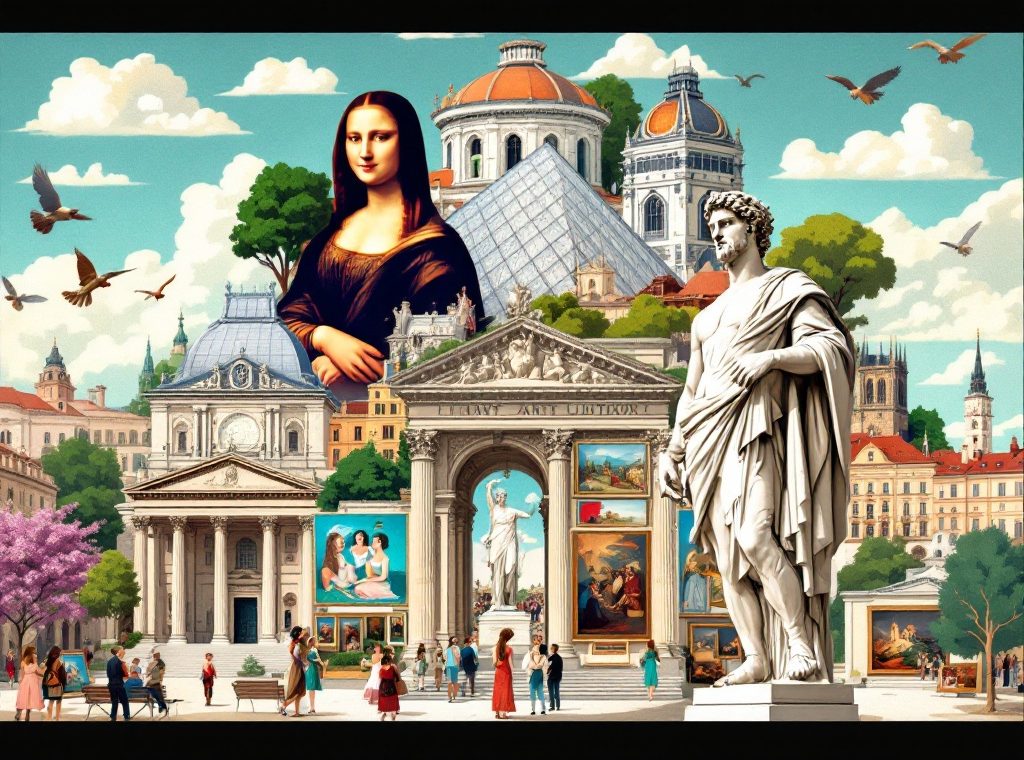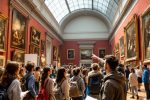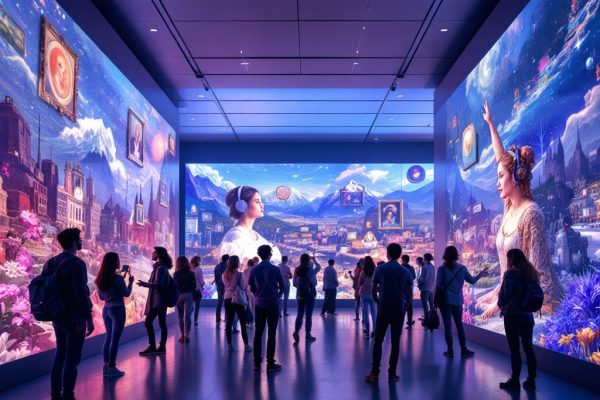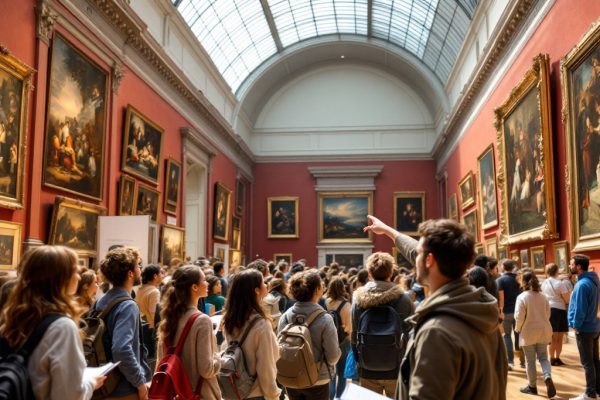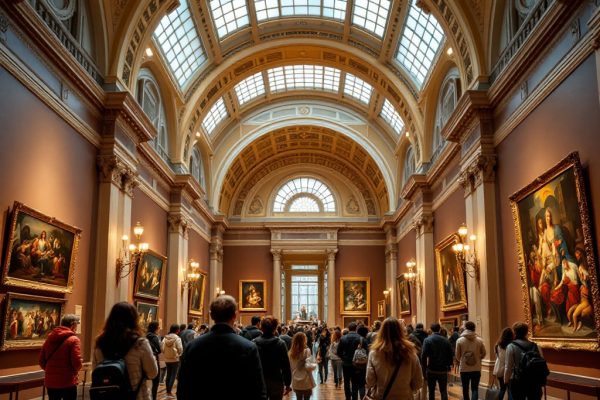Top Destinations for Students Interested in Art History
Envision yourself standing before the Mona Lisa in the Louvre or Michelangelo’s David in Florence. This dream can be your reality. Discover the world’s top art history destinations, from Renaissance Florence to Impressionist Paris, and ancient Athens to contemporary Prague. Explore iconic museums, architectural marvels, and vibrant cultural scenes. Uncover the secrets of art history firsthand. Start your artistic journey now!
Important information
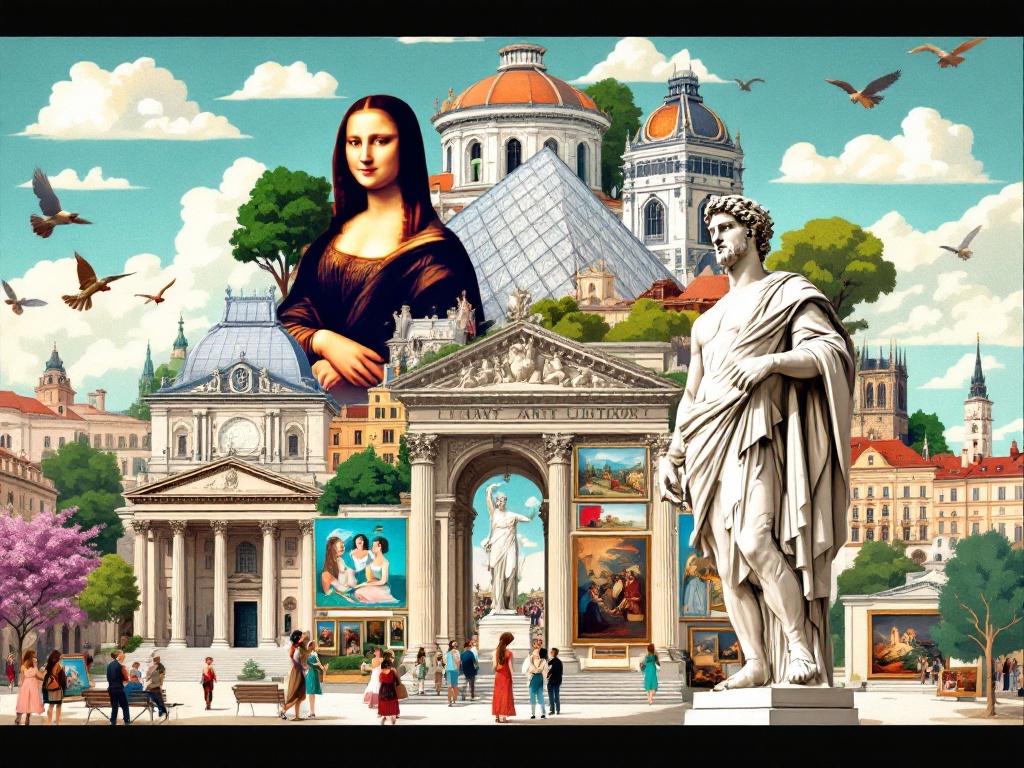
- Experiencing art in its original context brings greater understanding than studying reproductions.
- Florence offers Renaissance masterpieces and architecture, including works by Michelangelo and Botticelli.
- Paris provides access to Impressionist and Post-Impressionist art at the Musée d’Orsay and classic works at the Louvre.
- Athens allows for exploration of ancient Greek art and architecture at the Acropolis and National Archaeological Museum.
- Studying art history abroad offers cultural immersion, enriching the learning experience and providing exposure to diverse artistic movements.
Top Destinations for Students Interested in Art History
Europe, a haven for art enthusiasts, presents a diverse range of artistic experiences. From the Renaissance masterpieces in Florence, Italy, to the iconic Louvre Museum in Paris, France, art lovers can immerse themselves in centuries of artistic creation. Paris also showcases Impressionist treasures at the Musée d’Orsay. Meanwhile, Rome is brimming with ancient wonders. For classical art and ruins, Athens stands out as a must-visit destination. London beckons with the British Museum and the National Gallery, offering a glimpse into British and world art. Further south, Seville, Spain, displays the Alcázar Palace and captivating Gothic architecture. Beyond Europe, Prague showcases dynamic contemporary art. Kyoto offers an immersion into traditional Japanese arts. Mexico City pulsates with vibrant Muralism and rich indigenous culture. These destinations provide invaluable learning opportunities for art history students.
Why Study Art History Abroad?
Studying art history abroad is a truly enriching experience, immersing you in diverse cultures and allowing you to witness iconic artworks firsthand. This direct interaction breathes life into the subject, transforming textbook images into tangible masterpieces. Cultural immersion is crucial for understanding the historical context of art movements and their evolution. Imagine encountering the Mona Lisa in the Louvre—the impact is far greater than any reproduction. Experiencing art in its original setting deepens learning and creates unforgettable memories. Beyond famous masterpieces, studying abroad also exposes you to lesser-known works and emerging artists, broadening your art historical knowledge and enriching your understanding.
Benefits of Cultural Immersion
Immersing oneself in a culture breathes life into art and history. By engaging with local traditions, students gain a deeper understanding of art’s influences and connect more profoundly with cultural heritage. This firsthand experience enriches their grasp of the subject matter, making learning truly impactful.
Exposure to Classic Art Pieces
Experiencing classic art firsthand transforms our understanding. By studying brushstrokes, textures, and the true scale of a piece, we gain a deeper appreciation for the techniques, history, and cultural context. Reproductions simply cannot replicate the impact of encountering Michelangelo’s David in Florence or the Mona Lisa in the Louvre. These breathtaking experiences foster a profound connection with art history and amplify our understanding of art’s power. World-class museums like the British Museum or Athens’ National Archaeological Museum offer diverse collections spanning numerous artistic movements and historical periods, further enriching our perspective.
How to Choose the Right Destination for Your Art Studies
Choosing the right location for your art education is crucial. A region’s cultural heritage and history can significantly influence your artistic perspective. Consider exploring prominent art movements linked to various locations. A dynamic and diverse environment offers numerous learning opportunities.
Florence
Steeped in Renaissance masterpieces, Florence offers a unique immersion in classical art and techniques. Studying here provides access to iconic works and a rich artistic legacy.
Paris
The birthplace of Impressionism, Paris offers a contrasting experience, emphasizing modern and contemporary art movements. Its vibrant art scene and historical significance provide a diverse learning environment.
Reflect on what inspires you and choose a location that will nurture your creativity.
Considerations for Cultural Heritage and Art Movements
Italy’s profound influence on Renaissance art and architecture is evident in masterpieces by artists like Michelangelo and Leonardo da Vinci. France became the cradle of Impressionism and Post-Impressionism, showcased by iconic works such as Monet’s “Water Lilies” and Van Gogh’s “Starry Night”. Greece offers yet another crucial perspective with its ancient art and architecture, including the Acropolis, which are fundamental to understanding classical art.
Evaluating Artistic Perspectives and Creative Brilliance
Choosing the right place to study art is a big decision. The culture of a place can deeply shape an artist’s vision. Germany, with its rich history including the Bauhaus movement and German Expressionism, offers a unique perspective. The Netherlands is another great choice, home to masters like Rembrandt and Van Gogh, offering a different view of art history. Both countries provide amazing opportunities for future artists.
Germany
Rich heritage encompassing the Bauhaus movement and German Expressionism. Offers unique insights into these influential art movements.
The Netherlands
Home to masters like Rembrandt and Van Gogh. Provides a distinct perspective on art history through the works of Dutch masters.
Italy: A Dream Destination for Art History Students
Florence
Florence, the birthplace of the Renaissance, is a must-see for art lovers. Visit the Uffizi and Accademia Galleries to admire masterpieces by Michelangelo, Botticelli, and da Vinci. Explore architectural marvels like the Florence Cathedral and Palazzo Vecchio for a deeper understanding of the era.
Rome
Rome seamlessly blends ancient and Baroque influences, offering a unique cultural experience. Discover iconic landmarks such as the Colosseum and Pantheon. Explore the Vatican Museums‘ vast collection of art and artifacts. The city’s Baroque churches and fountains showcase the evolution of artistic styles.
Florence: Renaissance Art and Architecture
Florence flourished as the epicenter of the Italian Renaissance during the 14th century, experiencing a resurgence of interest in classical art and architecture. The city’s stunning Renaissance architecture is exemplified by the Florence Cathedral, a masterpiece designed by Filippo Brunelleschi. Its incredible art collections, housed in the Uffizi and Accademia Galleries, include iconic works like Michelangelo’s David and Botticelli’s Birth of Venus. These masterpieces not only showcase the era’s artistic innovations but also reveal the remarkable cultural blossoming of the Renaissance. Florence offers students unparalleled access to the key works and architectural wonders of this pivotal period, allowing them to experience its rich history firsthand.
Rome: Ancient and Baroque Architectural Marvels
Rome, a city where ancient ruins meet Baroque masterpieces, is a haven for art history enthusiasts. The Colosseum and Pantheon stand as testaments to Roman engineering. St. Peter’s Basilica exemplifies the grandeur of the Baroque period. Caravaggio’s dramatic paintings further capture the era’s artistic spirit. No trip is complete without a visit to the Vatican Museums, home to Michelangelo’s iconic Sistine Chapel ceiling, a pivotal work in understanding art history’s development.
Exploring Art and Culture in Paris, France
Paris’s Louvre Museum, home to iconic works like Da Vinci’s Mona Lisa, stands as a pillar of art and culture. Equally vital is the Musée d’Orsay, showcasing Impressionist and Post-Impressionist giants such as Monet and Van Gogh. Parisian art isn’t confined to museum walls. The city’s stunning architecture and thriving street art scene offer further creative exploration. This rich history and cultural heritage have nurtured diverse artistic movements, solidifying Paris’s place as a global art and culture hub.
The Louvre: Home to da Vinci and Classic Art
The Louvre Museum in Paris houses iconic artwork, including da Vinci’s Mona Lisa, offering visitors a remarkable experience. Its vast collection greatly benefits art history students, allowing them to experience classic art firsthand. The Louvre’s extensive holdings also provide essential context, deepening students’ understanding of various artistic movements and techniques. Art history students particularly benefit from visiting the Louvre. Experiencing these masterpieces firsthand allows students to connect with art in a profound way. The museum’s diverse collection helps students understand different artistic movements.
Musée d’Orsay: Impressionist Masters like Monet and Van Gogh
The Musée d’Orsay houses a stunning array of Impressionist and Post-Impressionist masterpieces, including iconic works by Claude Monet and Vincent van Gogh. It’s an ideal destination for students to explore 19th-century art movements and analyze the evolution of artistic styles, providing a rich learning experience.
Artistic Exploration in the United Kingdom
London.
London: Rich History of Art Movements
London has undeniably shaped art history, fostering numerous art movements. Its renowned galleries, such as the Tate Modern, National Gallery, and British Museum, showcase this rich heritage. Students in London benefit from access to diverse artistic styles and historical periods, gaining a unique educational perspective.
The British Museum and National Gallery
The British Museum houses a vast collection of global artifacts and art, spanning human history.
The National Gallery showcases European paintings, masterpieces from the 13th to 19th centuries, celebrating the continent’s artistic heritage.
Both offer unique and enriching experiences for any art or history enthusiast.
Discovering Ancient Art in Athens, Greece
Athens, Greece, is a haven for students of ancient art, offering unparalleled access to the foundations of Western art. The Acropolis, crowned by the Parthenon, exemplifies classical Greek architecture and sculpture, allowing visitors to experience these iconic works firsthand. The National Archaeological Museum houses an extensive collection of Greek artifacts, from pottery to exquisite jewelry. Together, these sites demonstrate the evolution of artistic techniques and illuminate the cultural context in which these masterpieces were created, bringing the ancient world vividly to life.
The Acropolis and National Archaeological Museum
The Acropolis, a historic citadel, showcases iconic structures like the Parthenon, providing crucial insights into Greek art.
The National Archaeological Museum houses a vast collection of Greek artifacts spanning prehistory to late antiquity.
Together, these destinations offer invaluable perspectives on Greek art and history.
Seville, Spain: A Blend of History and Art
Seville captivates visitors with its unique blend of history and art. The Alcázar Palace stands as a stunning example of Moorish and Gothic architecture, while the Plaza de España embodies Baroque grandeur. This striking contrast offers valuable insights into different periods of artistry and design.
Alcázar Palace
The Alcázar’s intricate details speak to the strong Moorish influence.
Plaza de España
The Plaza de España showcases the drama and extravagance of the Baroque period.
Seville’s rich heritage is on full display through these iconic landmarks.
Alcázar Palace and Gothic Architecture
The Alcázar of Seville seamlessly blends Mudéjar and Gothic architecture, offering a stunning display of Spanish art and culture. This palace provides a rich insight into Spain’s vibrant past and is a must-see for art history students.
Baroque Influence at the Plaza de España
Seville’s Plaza de España is a breathtaking example of Baroque Revival architecture, characterized by ornate details and a grand scale. Renaissance and Moorish influences add a unique twist, resulting in a fascinating fusion of architectural styles. This landmark offers art history enthusiasts, especially students, a rich visual experience and a compelling example of intertwining artistic movements.
Kyoto, Japan: Traditional Japanese Arts
Experience traditional Japanese arts in Kyoto.
Partake in the serene ritual of a tea ceremony.
Witness the dynamic strokes of Japanese calligraphy.
Admire the delicate artistry of ikebana (flower arranging).
Explore temples, shrines, and gardens showcasing stunning architecture, paintings, and sculptures.
Visit the Nishijin textile district, renowned for its exquisite kimono fabrics and ancient weaving techniques.
Experience the unforgettable spectacle of Fushimi Inari Shrine with its thousands of vibrant red torii gates.
In Gion, Kyoto’s geisha district, catch a glimpse of traditional performing arts.
Discover Kyoto’s renowned crafts, including Kiyomizu-yaki pottery and intricate lacquerware.
Participate in hands-on workshops or simply stroll through Kyoto’s streets for a profound cultural immersion.
Experience Cultural Heritage and Visual Arts
Kyoto seamlessly blends cultural heritage with visual arts. Explore traditional Japanese crafts such as Nishijin-ori textiles and Kiyomizu-yaki pottery. Experience captivating performances of Noh and Kabuki theatre, showcasing Japan’s rich artistic legacy. At Fushimi Inari Shrine, thousands of vibrant red torii gates create a mesmerizing visual spectacle. In Gion, Kyoto’s geisha district, witness traditional arts like dance, music, and the tea ceremony, offering valuable insights into Japan’s artistic traditions.
Mexico City, Mexico: Muralism and Indigenous Cultures
Mexico City’s vibrant art scene is renowned for its muralism movement, featuring iconic artists like Diego Rivera, José Clemente Orozco, and David Alfaro Siqueiros. These powerful, often massive works explore Mexican history and social issues. Beyond murals, the city offers a gateway to indigenous cultures.
Templo Mayor
Templo Mayor showcases the ruins of Tenochtitlan’s main temple, the heart of the Aztec capital. Exploring this site offers a direct connection to Mexico City’s pre-Hispanic past.
National Museum of Anthropology
The National Museum of Anthropology houses an extensive collection of pre-Hispanic artifacts. These artifacts provide glimpses into the fascinating ancient civilizations that shaped Mexico.
Templo Mayor and the National Museum of Anthropology
Explore ancient Mexico City with a visit to the Templo Mayor, the ruins of the Aztec’s main temple in Tenochtitlan. These remnants offer a fascinating glimpse into a powerful civilization. Continue your journey at the National Museum of Anthropology, home to a vast collection of pre-Hispanic artifacts. Indigenous art takes center stage, showcasing intricate sculptures and vibrant pottery. Both sites are invaluable resources for art history students studying Mexican indigenous cultures. Anyone with an interest in history and art will find these locations captivating and insightful.
Hidden Gems for Art History Enthusiasts
Prague flourishes as a center of contemporary art, with its many galleries exhibiting modern and contemporary masterpieces. Art lovers can explore current trends, going beyond traditional aesthetics.
The Netherlands, the birthplace of famous artists such as Rembrandt and Vermeer, offers a different perspective. Students can delve into the world of the Dutch Masters at various museums and historical sites, gaining a deeper appreciation of their influence on art history.
Prague, Czech Republic: Contemporary Art Scene
Prague is rapidly emerging as a key center for contemporary art. Its distinct history has fostered a dynamic and thought-provoking art scene, making it a perfect destination for students interested in modern and contemporary art. They will find Prague a rich source of inspiration.
The Netherlands: Birthplace of Notable Artists
From Rembrandt to Vermeer to Van Gogh, the Netherlands boasts a rich artistic heritage, making it an ideal destination for art history studies and a paradise for art lovers.

